Winter can be a beautiful season, with snow blanketing homes and trees creating a serene landscape. However, hidden beneath this winter wonder can be a significant threat to your home’s roof—ice dams. These thick, ridge-like formations of ice along the edge of your roof may look harmless, even picturesque, but they can lead to serious issues if not addressed. Let’s explore how ice dams form, the dangers they pose, and what you can do to prevent them from causing roof damage.
How Do Ice Dams Form?
Ice dams occur when snow on a roof melts and then refreezes along the colder eaves, creating a wall of ice that traps further melting snow. The process begins when warm air from inside the house escapes into the attic and heats the roof’s surface. This heat causes the snow to melt and flow down toward the eaves. However, because the eaves are colder than the rest of the roof, the water refreezes there, forming a “dam” of ice. As more snow melts and flows down, it continues to build up behind the dam, leading to a larger, more problematic ice formation.
Key Factors Contributing to Ice Dams
Several factors contribute to the formation of ice dams, including:
- Insufficient attic insulation: Without proper insulation, heat can escape into the attic, warming the roof and leading to snow melt.
- Poor ventilation: Good ventilation keeps the attic cool, which reduces the likelihood of snow melting unevenly.
- Weather conditions: Alternating periods of snow, melting, and refreezing create ideal conditions for ice dam formation.
These elements combined make ice dams a common issue in regions with heavy snowfall and fluctuating winter temperatures.
The Dangers of Ice Dams on Your Roof
When ice dams form, they can create more than just a nuisance. They can cause real damage to your roof, walls, insulation, and even the interior of your home. Here’s how ice dams can lead to costly problems.
Water Backup and Leaks
One of the biggest issues with ice dams is the water backup they cause. As melting snow gets trapped behind the ice dam, the water has nowhere to go, so it often seeps under shingles and leaks into the roof deck. This can eventually penetrate your roof’s underlayment and insulation, leading to water stains on ceilings, peeling paint, or even structural damage. S
Shingle and Roof Deck Damage
Ice dams put excessive pressure on shingles, loosening them or causing cracks. Over time, this constant freeze-thaw cycle can lead to worn or missing shingles, which weakens the roof’s ability to protect your home. Furthermore, the wooden roof deck, which forms the core of your roof structure, can deteriorate due to prolonged water exposure.
Mold and Mildew Growth
Ice dams not only damage the roof but also increase the risk of mold and mildew inside your home. When water seeps into the attic, it creates a damp environment where mold can thrive. This can lead to poor indoor air quality and health concerns for residents, especially for those with respiratory conditions.
Preventing Ice Dams and Protecting Your Roof
Since ice dams can lead to extensive and costly repairs, prevention is essential. Here are several effective ways to reduce the risk of ice dams forming on your roof.
Improve Attic Insulation and Ventilation
Proper insulation and ventilation are your best defenses against ice dams. By ensuring your attic remains as close to outdoor temperatures as possible, you prevent the snow on your roof from melting unevenly. Adding insulation can help keep warm air from leaking into the attic, while ventilation—such as ridge vents or soffit vents—allows cold air to flow through, keeping the roof surface cool.
Use Heat Cables
In areas prone to ice dams, heat cables are a helpful solution. Installed along the roof edge, heat cables prevent ice from forming by maintaining a consistent temperature. While this may not be a permanent fix, it’s an effective solution for severe winters.
Regular Roof Maintenance
Before winter sets in, it’s wise to inspect and maintain your roof. Clear out any debris in your gutters, as clogged gutters can prevent water from draining properly, worsening the effects of ice dams. Additionally, check for any loose or damaged shingles that might be susceptible to leaks.
Consider Professional Solutions
If you live in an area with harsh winters and have dealt with ice dams in the past, hiring a roofing professional to assess your insulation and ventilation might be a wise investment. Roofing experts can identify weak points and suggest upgrades that may prevent ice dams from forming in the future.
What To Do If Ice Dams Are Already Forming
Despite taking preventative steps, sometimes ice dams still form. If you notice ice building up along your roofline, act quickly to reduce damage. Here are a few safe and effective actions:
- Use a roof rake: Carefully rake snow off your roof to reduce the weight and lessen the chance of snowmelt. Be cautious not to damage your shingles.
- Apply de-icing products: Non-corrosive de-icing agents, like calcium chloride, can melt ice dams. However, be sure not to use rock salt, which can damage your roof materials.
- Hire a professional for ice removal: Removing ice dams can be dangerous, especially on sloped roofs. Hiring a professional with the proper equipment and expertise can prevent accidents and damage to your roof.
The Cost of Ignoring Ice Dams
Ignoring ice dams can lead to severe structural damage, turning a small repair into a costly renovation. Homeowners who allow ice dams to persist may face not only roof repairs but also water damage, mold remediation, and interior restoration costs. Keeping a watchful eye on your roof during winter and acting at the first signs of ice dams is crucial to maintaining your home’s value and safety.
Final Thoughts

While they may seem like a small winter inconvenience, ice dams can cause significant roof damage if left unchecked. The good news is that with proper attic insulation, ventilation, and regular roof maintenance, you can reduce the chances of ice dams forming and keep your roof in top condition through the coldest months. Protecting your home from ice dams is a worthwhile investment in your property’s health and safety. For expert advice and assistance, contact DryTech Exteriors today to keep your roof safe from winter’s worst.




